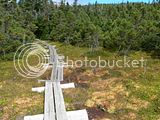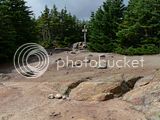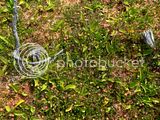arghman
New member
- Joined
- Sep 1, 2004
- Messages
- 1,352
- Reaction score
- 153

I hiked the Wildcats and Carter Range on Monday and Tuesday with a friend who is finishing up her NH4Ks (eight to go!). We went S->N on the AT from Pinkham Notch to the North Carter Trail (at which point I did a quick side trip to the summit of North Carter) and down via the Imp Face. We stayed at Carter Notch Hut.
Highlights & things to add/emphasize above what's in the White Mtn Guide:
1) Carter Notch Hut is cool!!!!! The kitchen is stocked very well (as MichaelJ and other people mentioned in answering my Q&A post) and I found the atmosphere a lot more relaxing than the full-service huts, plus the price is a lot easier on the wallet. The bunkhouses have rooms of 4 and 6 bunks (stacked two high), similar to Lonesome Lake. The others (not sure about Galehead or Zealand; I can't remember Zealand and haven't been to Galehead) have larger bunkrooms.
2) Footing is very good on most of the trail. There were a few slabby areas just west of Wildcat D, that might be tricky in the rain, but there's been a lot of trailwork on the AT and much of it is well-placed rock steps, including the steep sections between Wildcat A down to Carter Notch and up to Carter Dome.
3) arghman's ratings:
Middle Carter: A. Lots of terrain and habitat variety, relatively easy flat sections of trail. Some with open heath & great views, others with wooded shade (including the summit itself), bog bridges, and one interesting small open bog.

Imp Face: A. Great views, neat place to stop a while.
Hight: A-. This is the best in terms of views, with maybe an acre of open alpine zone. I only rated this an A- instead of A because I was perhaps expecting a larger variety of flora.
Ramparts: B+. A neat little area in Carter Notch consisting of a bunch of boulders strewn around. Explore this if you have time & energy.
Carter Dome: B. The highest point in the ridge, wooded but with some good viewpoints nearby.
North Carter: B-. A quick hike (1/3 mile) from the North Carter Trail, <100ft elevation gain, but not much to see. The summit area itself is barren but surrounded by woods; it has had all of its vegetation eroded off & was somewhat depressing.

South Carter: B-. Don't remember much about it.
Wildcat A: C. Don't remember much, we were tired of the Wildcats at this point.
Wildcat D/E/etc. C-, and I'm being kind. The ski lift & observation platform ruins any redeeming qualities, IMHO. The Wildcat ridge is a bunch of up & down, & I think what makes it so bad is you have no idea how far you are. (is this Wildcat H? G? F?)
[When did the Wildcat summits get letters, by the way? They don't show up on the USGS maps at all; they are on a copy I have of the AMC Mt Washington Range map from 1966. My pet theory is that the derivation is from a Dr Seuss book
Overall: B, though a very memorable B. I'd nominate the Wildcats and Carters as "Honorary Mahoosucs" or at least Mahoosuc wannabees. It's as though someone was trying real hard... they got the ups&downs right, though a little overdone, and there's a few bogs... somehow it's just not as Mahoosuc-y. (I am, however, looking forward to hiking the stretch between North Carter and Shelburne Moriah. I've been to Shelburne Moriah and know enough about the rest of the ridge to want to redline this section of the AT. Definitely.)
The views to the west and east are certainly memorable, though. West to see the Presidential Range fairly close by (Washington was briefly out of the clouds Monday), and East to look at the Baldfaces and Eagle Crag and Kezar Lake across the vast Wild River Valley of the township of Beans Purchase.
4) Flora
"While we were labouring up the mountain I twice exclaimed, a Heath! and was as often disappointed." --William Peck, in a letter to B. S. Barton ca. 1805/1806 (from "Notes on the Botanical Exploration of the White Mountains", Arthur S. Pease, Appalachia, Vol. XIV, No. 2, p. 162)
No rare species encountered. I am neglecting the common forested stuff (wood sorrel, twisted-stalk, false hellebore, goldthread, bunchberry, fir, spruce, etc.) as I tend to focus on the above-treeline flora.There's a small ledgy area (see Washburn's map) at 3800 ft or so, west of Wildcat E, which has heathy stuff: blueberries (Vaccinium spp.) + mountain cranberry (V. vitis-idaea) + crowberry (Empetrum sp., either E. nigrum or E. eamesii but they're hard to distinguish w/o a hand lens to look for leaf hairs.)
The Ramparts have the above species + I'm pretty sure it had bog bilberry (Vaccinium uliginosum). Loads of mountain cranberry fruit around, I ate too many. There was one patch of crowberry where fruit was abundant, otherwise berries were very rare.
Hight had the same species as the Ramparts, + mountain sandwort (Minuartia groenlandica) which is a usual suspect in alpine zones which have seen trampling disturbance.
Middle Carter: open areas south of the summit are interesting and had the same species as the Ramparts, plus small cranberry (Vaccinium oxycoccos) along edges of the trail where sphagnum moss was present. Blueberry with berries were most abundant here, in passable quantities; the rest of the hike they were rare (or may have all been eaten by now). V. oxycoccos was also abundant in the bog between Middle Carter and the North Carter trail; there was also either clintonia (Clintonia borealis) or Canada mayflower (Maianthemum canadense) as one of the dominant species in the bog, which seemed unusual. A few drier hummocks had patches of crowberry.

I wonder if the Carters were burned badly in the 1903 fire (one book I have cites Mt Hight's baldness to this fire); in general there were a few species that seemed "missing" from this bog or from the range as a whole. No three-toothed-cinquefoil except on the Imp Face, for example, whereas this plant is common almost everywhere in the 4000-5000ft alpine zone in the Presidentials. (disclosure: I am not a trained botanist so my conclusions are questionable)
Imp Face: Three-toothed cinquefoil (Sibbaldiopsis tridentata) and one of the goldenrods, probably Rand's (Solidago simplex).
5) Other hikers: Most of the hikers we saw seemed to be AT thru-hikers. We ran into a number of hikers while we were heading down the N. Carter and Imp trails, including one group with 3 adults and 3 or 4 children in the 10-13 year age range, who I seem to remember saying they were attempting to bag two 4K peaks and this was their first time doing so.
6) Hitchhiking: We were pretty lousy hitchhikers. No luck on Rt 16 & we ended up walking south rather dejectedly. At the 19-Mile Brook Trailhead we saw someone coming back to their car from the trail & got a ride back to Pinkham. (to the guy from Somerville with the two-door car, thank you thank you thank you!!!!)
On the whole, this trip and our hitchhiking attempt (and some other events that have happened recently to people & places I know, many unrelated to this hike) have made me somewhat contemplative on the roles of Free Will and Fate, and the control we have on what happens to us... sometimes I think I have more control when I am out hiking than when I am back in the "real world".
Anyway I've got my share of Beans Purchase for a while.
